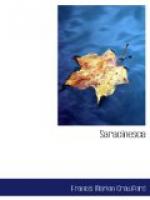As for the fashions of those days, it is probable that most of us would suffer severe penalties rather than return to them, beautiful as they then appeared to us by contrast with the exaggerated crinoline and flower-garden bonnet, which had given way to the somewhat milder form of hoop-skirt madness, but had not yet flown to the opposite extreme in the invention of the close-fitting princesse garments of 1868. But, to each other, people looked then as they look now. Fashion in dress, concerning which nine-tenths of society gives itself so much trouble, appears to exercise less influence upon men and women in their relations towards each other than does any other product of human ingenuity. Provided every one is in the fashion, everything goes on in the age of high heels and gowns tied back precisely as it did five-and-twenty years ago, when people wore flat shoes, and when gloves with three buttons had not been dreamed of—when a woman of most moderate dimensions occupied three or four square yards of space upon a ball-room floor, and men wore peg-top trousers. Human beings since the days of Adam seem to have retired like caterpillars into cocoons of dress, expecting constantly the wondrous hour when they shall emerge from their self-woven prison in the garb of the angelic butterfly, having entered into the chrysalis state as mere human grubs. But though they both toil and spin at their garments, and vie with Solomon in his glory to outshine the lily of the field, the humanity of the grub shows no signs of developing either in character or appearance in the direction of anything particularly angelic.
It was not the dress of the period which gave to the streets of Rome their distinctive feature. It would be hard to say, now that so much is changed, wherein the peculiar charm of the old-time city consisted; but it was there, nevertheless, and made itself felt so distinctly beyond the charm of any other place, that the very fascination of Rome was proverbial. Perhaps no spot in Europe has ever possessed such an attractive individuality. In those days there were many foreigners, too, as there are to-day, both residents and visitors; but they seemed to belong to a different class of humanity. They seemed less inharmonious to their surroundings then than now, less offensive to the general air of antiquity. Probably they were more in earnest; they came to Rome with the intention of liking the place, rather than of abusing the cookery in the hotels. They came with a certain knowledge of the history, the literature, and the manners of the ancients, derived from an education which in those days taught more through the classics and less through handy text-books and shallow treatises concerning the Renaissance; they came with preconceived notions which were often strongly dashed with old-fashioned prejudice, but which did not lack originality: they come now in the smattering mood, imbued with no genuine beliefs, but covered with exceeding thick




